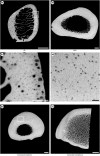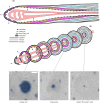Intracortical remodelling increases in highly loaded bone after exercise cessation
- PMID: 37953410
- PMCID: PMC10862154
- DOI: 10.1111/joa.13969
Intracortical remodelling increases in highly loaded bone after exercise cessation
Abstract
Resorption within cortices of long bones removes excess mass and damaged tissue and increases during periods of reduced mechanical loading. Returning to high-intensity exercise may place bones at risk of failure due to increased porosity caused by bone resorption. We used point-projection X-ray microscopy images of bone slices from highly loaded (metacarpal, tibia) and minimally loaded (rib) bones from 12 racehorses, 6 that died during a period of high-intensity exercise and 6 that had a period of intense exercise followed by at least 35 days of rest prior to death, and measured intracortical canal cross-sectional area (Ca.Ar) and number (N.Ca) to infer remodelling activity across sites and exercise groups. Large canals that are the consequence of bone resorption (Ca.Ar >0.04 mm2 ) were 1.4× to 18.7× greater in number and area in the third metacarpal bone from rested than exercised animals (p = 0.005-0.008), but were similar in number and area in ribs from rested and exercised animals (p = 0.575-0.688). An intermediate relationship was present in the tibia, and when large canals and smaller canals that result from partial bony infilling (Ca.Ar >0.002 mm2 ) were considered together. The mechanostat may override targeted remodelling during periods of high mechanical load by enhancing bone formation, reducing resorption and suppressing turnover. Both systems may work synergistically in rest periods to remove excess and damaged tissue.
Keywords: bone; exercise; resorption; rest.
© 2023 The Authors. Journal of Anatomy published by John Wiley & Sons Ltd on behalf of Anatomical Society.
Conflict of interest statement
The authors have no conflict of interest.
Figures






References
-
- Allen, M.R. , Iwata, K. , Phipps, R. & Burr, D.B. (2006) Alterations in canine vertebral bone turnover, microdamage accumulation, and biomechanical properties following 1‐year treatment with clinical treatment doses of risedronate or alendronate. Bone, 39, 872–879. Available from: 10.1016/j.bone.2006.04.028 - DOI - PubMed
-
- Andreasen, C.M. , Bakalova, L.P. , Brüel, A. , Hauge, E.M. , Kiil, B.J. , Delaisse, J.‐M. et al. (2020) The generation of enlarged eroded pores upon existing intracortical canals is a major contributor to endocortical trabecularization. Bone, 130, 115127. Available from: 10.1016/j.bone.2019.115127 - DOI - PubMed
-
- Andreasen, C.M. , Delaisse, J.‐M. , van der Eerden, B.C. , van Leeuwen, J.P. , Ding, M. & Andersen, T.L. (2018) Understanding age‐induced cortical porosity in women: the accumulation and coalescence of eroded cavities upon existing intracortical canals is the Main contributor. Journal of Bone and Mineral Research, 33, 606–620. Available from: 10.1002/jbmr.3354 - DOI - PubMed
Publication types
MeSH terms
Associated data
Grants and funding
LinkOut - more resources
Full Text Sources
Research Materials

